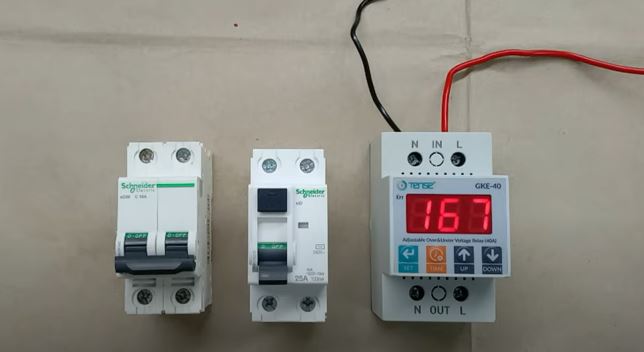Overcurrent protection devices are important in electrical wiring installations for several reasons.
| First | They help to protect the wiring from damage due to overcurrent conditions. |
| Second | They help to prevent fires by interrupting the circuit when an overcurrent condition is detected. |
| Third | They provide a measure of safety for people and animals who may come into contact with the electrical circuit. |
Overcurrent protection is one of the most important aspects of electrical wiring installations. Overcurrent devices are designed to protect circuits from damage caused by too much current flowing through them. Without these devices, electrical fires would be much more common.

There are two main types of overcurrent devices: circuit breakers and fuses. Circuit breakers interrupt the flow of electricity when they sense that too much current is flowing through a circuit. Fuses work by melting when too much current flows through them, which breaks the circuit and prevents further damage.
Both circuit breakers and fuses are essential for protecting your home or business from fire hazards. It’s important to choose the right size of overcurrent device for your circuit, as well as make sure that it’s properly installed by a licensed electrician.
What is the Importance of Overcurrent Protective Devices?
Overcurrent protective devices (OPDs) are important for the safe operation of electrical systems. They are designed to protect against overcurrents, which can damage equipment and cause fires. OPDs are typically installed in circuit breakers, fuses, and other electrical devices.
What is the Function of a Protective Device in Electrical?
A protective device is a device that is used to protect an electrical circuit from damage due to overcurrent or overvoltage. Protective devices are typically installed in electrical panels, switchgear, and other equipment to prevent damage to the equipment and to minimize the risk of fire or electrocution.
How Do Overcurrent Protection Devices Work?
Overcurrent protection devices are designed to protect electrical circuits from damage due to excessive current. These devices can be used in a variety of applications, including circuit breakers, fuses, and overcurrent relays. How do they work?
Overcurrent protection devices work by interrupting the flow of current when it exceeds a certain threshold. This interruption can be accomplished either by mechanical means (such as a breaker) or by electronic means (such as a transistor). What are the benefits?
Overcurrent protection devices can help to prevent fires and other damage caused by excessive current. They can also prolong the life of electrical equipment by preventing damage from overheating. There are several different types of overcurrent protection devices available on the market today.
Circuit breakers are perhaps the most common type of device, and they are available in both residential and commercial settings. Fuses are another type of overcurrent protection device, but they are not as common as circuit breakers. Overcurrent relays are used in some industrial applications, but they are not as widely used as circuit breakers or fuses.
What is Overcurrent As Used in Electrical Circuit?
Overcurrent is an important safety feature in electrical circuits. It protects against damage to the circuit by preventing too much current from flowing through it. Overcurrent can be caused by a number of things, including a short circuit, faulty wiring, or a loose connection.
When overcurrent occurs, the circuit breaker trips and cuts off the flow of electricity. This prevents the circuit from being overloaded and keeps it from being damaged.
Types of Overload Protection Devices

Overload protection devices are used in electrical circuits to protect against excessive currents. There are three main types of overload protection devices: fuses, circuit breakers, and contactors.
Fuses
Fuses are the most common type of overload protection device. A fuse is a thin piece of metal that melts when too much current flows through it, thus breaking the circuit and preventing further flow of current. Fuses must be replaced when they “blow,” meaning they can only be used once.
Circuit Breaker
Circuit breakers are similar to fuses in that they protect against excessive currents by interrupting the circuit.
However, unlike fuses, circuit breakers can be reset after they trip, making them more convenient to use than fuses.
Contactors
Contactors are heavy-duty switches that are used to control high-power circuits such as those found in electric motors and air compressors. Contactors have two sets of contacts: one set that is controlled by an electromagnet, and another set that is spring-loaded.
When the electromagnet is energized, it closes the contacts, allowing current to flow; when the electromagnet is de-energized, the spring-loaded contacts open, interrupting the circuit.
Three Methods of Overcurrent Protection
There are three primary methods of overcurrent protection – fuses, circuit breakers, and ground fault circuit interrupters (GFCIs). Each has its own advantages and disadvantages, so it’s important to choose the one that best meets your needs. Fuses are the oldest and most basic form of overcurrent protection.
They work by containing a small piece of metal that melts when too much current flows through it, thereby breaking the circuit and stopping the flow of electricity.
Fuses
Fuses are relatively inexpensive and simple to use, but they must be replaced after they have been used once. Additionally, if a fuse blows often, it may be an indication that there is a more serious problem with the electrical system.
Circuit Breakers
Circuit breakers are a more modern form of overcurrent protection. They work by using electromagnets to open and close contacts that complete or break the circuit. Circuit breakers can be reset after they trip, which makes them more convenient than fuses.
However, they are also more expensive than fuses.
Ground Fault Circuit Interrupters (GFCIs)
Ground fault circuit interrupters (GFCIs) are designed to protect against electrical shocks caused by faulty wiring or damaged cords. GFCIs work by constantly monitoring the amount of current flowing through the circuitry.
If there is an imbalance – such as would occur if someone were to come into contact with a live wire – the GFCI trips and shuts off power to the circuit before anyone can be harmed. GFCIs can be used in both homes and businesses, and are required by law in some areas. While they provide an important safety function, GFCIs can sometimes trip unnecessarily due to factors such as humidity or loss of connections.
Examples of Overcurrent Protection Devices
Overcurrent protection devices are designed to protect electrical circuits from damage due to excessive current. There are many different types of overcurrent protection devices available, each with its own advantages and disadvantages. Some of the most common overcurrent protection devices include fuses, circuit breakers, and thyristors.
Fuses are perhaps the most well-known type of overcurrent protection device. Fuses work by interrupting the flow of current when it becomes too high, thus preventing damage to the electrical circuit. Fuses are relatively simple and inexpensive devices, but they have a few drawbacks.
| First | Once a fuse has been blown, it must be replaced before the circuit can be used again. |
| Second | Fuses may not provide adequate protection for high-powered circuits. |
| Third | Circuit breakers are another type of overcurrent protection device. |
Circuit breakers work by sensing when the current in a circuit is getting too high and then automatically disconnecting the circuit until the problem is resolved. Circuit breakers can be reset after an overcurrent event, which makes them more convenient than fuses. However, they may not provide as much protection as fuses since they only disconnect the circuit rather than interrupt the flow of current.
Thyristors are semiconductor devices that can be used as overcurrent protection devices. Thyristors work by allowing current to flow through them when the voltage is below a certain threshold; however, when the voltage exceeds this threshold, the thyristor will become nonconductive and block further current from flowing.
Overcurrent Protection Circuit

An overcurrent protection circuit is a device that is used to protect an electrical circuit from damage due to too much current flowing through it. This type of device is usually placed in between the power source and the load, and it will interrupt the flow of current if it exceeds a certain threshold. There are many different types of overcurrent protection devices, each with its own advantages and disadvantages.
The most common type is the fuse, which will blow when too much current flows through it, breaking the circuit and preventing further damage. However, fuses can be damaged by repeated overcurrents, so they may need to be replaced frequently. Another type of overcurrent protection device is the breaker, which trips when too much current flows through it and can be reset when the problem has been fixed.
Breakers are more expensive than fuses but they last longer and can be reused many times.
It is Very Important in the Context of Power System Protection?
One of the most important aspects of power system protection is coordination. Coordination ensures that the right devices are activated at the right time to protect the system. Without coordination, devices could trip unnecessarily, causing a loss of power or even damage to equipment.
Why is a Control Device Used on an Electrical Circuit?
A control device is used on an electrical circuit for two main reasons: to protect the circuit from overload and to provide a way to turn the circuit off.
Overload protection is important because it prevents damage to the wires and components in the circuit. An overload can happen if too much current flows through the circuit.
This can be caused by a short circuit, where the wires touch each other, or by a faulty appliance that draws too much current.
The control device provides a way to turn the circuit off so that repairs can be made or so that the appliance can be replaced. In some cases, the control device may also provide a way to reduce the amount of current flowing through the circuit.
This can help prevent damage to sensitive equipment or help improve energy efficiency.
What is Overcurrent Protective Device With a Circuit Opening?
An overcurrent protector is a circuit-opening device that is used to protect against excessive current. It is usually installed in electrical circuits to prevent damage from overload or short circuits. Overcurrent protectors can be found in many different types of devices, including fuses, circuit breakers, and thyristors.
Overcurrent Protection

Overcurrent protection is a critical component of any electrical system. Without it, circuits can overheat and potentially catch fire. Overcurrent protection devices are designed to protect circuits from damage by automatically disconnecting them when an overcurrent condition is detected.
There are two main types of overcurrent protection devices: fuses and circuit breakers. Fuses are one-time-use devices that must be replaced after they have been used to interrupt a circuit. Circuit breakers can be reset and reused multiple times.
Both types of devices work by interrupting the flow of current in a circuit when an overcurrent condition is detected. Overcurrent protection devices are typically selected based on the amount of current they can safely interrupt. This is known as the device’s interrupting rating or capacity.
The National Electrical Code (NEC) requires that overcurrent protection devices have an interrupting rating that is equal to or greater than the maximum short-circuit current that the device may encounter in its application. It is important to note that overcurrent protection devices do not provide 100% Protection against all possible overload conditions. They only provide a level of safety against conditions that could cause damage to equipment or pose a fire hazard.
Bottom Line
Overcurrent protective devices, like circuit breakers and fuses, are a crucial part of any electrical wiring installation. They help to prevent damage to your home or office by protecting against overcurrents, which can cause fires.
Read More:
- Does Battery Saver Affect Adventure Sync?
- What Causes Laptop Battery Capacity to Decrease?
- How Important is a Battery Management System in a Lithium Battery?
- What is the Discharge Power of a Battery?
Used Resources:
